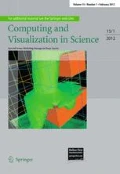Abstract
Quantitative descriptors of intrinsic properties of fMRI data can be obtained from the theory of random matrices. We study data reduction based on the comparison of empirical correlation matrices with a suitably chosen ensemble of random positive matrices. Accordingly, data dimensions can be discarded if the quality of fit of the data spectrum deviates locally from the theoretical result, which is derived here analytically. Further, more complex quantities such as the number variance are discussed and shown to be potentially useful in an analogous manner.
Similar content being viewed by others
References
Alon N., Krivelevich M., Vu V.H. (2002) On the concentration of eigenvalues of random symmetric matrices. Israel J. Math. 131, 259–268
Beenakker, C.W.J.: Random-matrix theory of quantum transport. Rev. Modern Phys. 69(3) (1997)
Brody, T.A., Flores, J., French, J.B., Mello, P.A., Pandey, A., Wong, S.S.M.: Random-matrix physics: spectrum and strength fluctuations. Rev. Modern Phys. 53(3) (1981)
Dodel, S.: Data driven analysis of brain activity and functional connectivity in fMRI. Göttingen University (2000)
Dodel S., Herrmann J.M., Geisel T. (2000) Localization of brain activity—blind separation for fMRI data. Neurocomputing 32–33, 701–708
Dodel, S., Herrmann, J.M., Geisel, T.: Stimulus-independent data analysis for fMRI. In: Emergent Neural Computational Architectures Based on Neuroscience—Towards Neuroscience-Inspired Computing. Lecture Notes in Computer Science 2036, pp. 39–53. Springer, Berlin Heidelberg New York (2001)
Guhr, T., Ma, J.-Z., Meyer, S., Wilke, T.: Statistical analysis and the equivalent of a thouless energy in lattice qcd dirac spectra. Phys. Rev. D 59 (1999)
Mehta M.L. (1991) Random Matrices. Academic, Boston
Voultsidou M., Dodel S., Herrmann J.M. (2005) Neural networks approach to clustering of activity in fmri data. IEEE Trans. Med. Imaging 12(8): 987–996
Wigner E.P. (1967) Random matrix theory in physics. SIAM Rev. 9, 1–23
Author information
Authors and Affiliations
Corresponding author
Additional information
Communicated by G.Wittum.
Rights and permissions
About this article
Cite this article
Voultsidou, M., Dodel, S. & Herrmann, J.M. Feature evaluation in fMRI data using random matrix theory. Comput. Visual Sci. 10, 99–105 (2007). https://doi.org/10.1007/s00791-006-0037-6
Received:
Accepted:
Published:
Issue Date:
DOI: https://doi.org/10.1007/s00791-006-0037-6




